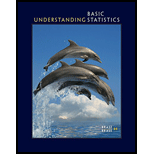
Concept explainers
(a)
To find: The pooled
(a)
Answer to Problem 5P
Solution: The pooled probability of success is
Explanation of Solution
Calculation: Using,
Now, the pooled probability of success is calculated as follows:
Thus, the probability of success is 0.66.
Now the value of the
Thus, the probability of failure is 0.34.
(b)
Whether we should use
(b)
Answer to Problem 5P
Solution: The sample test statistic follows standard normal distribution.
Explanation of Solution
The number of binomial trials is large enough that each of the products
(c)
The null and alternate hypothesis.
(c)
Answer to Problem 5P
Solution: The hypotheses are
Explanation of Solution
Since, we want to conduct a test of the claim that the probability of success of the two binomial experiments are differ. Therefore, the null hypothesis is
(d)
To find: The difference of sample proportion
(d)
Answer to Problem 5P
Solution: The difference of sample proportion
Explanation of Solution
Calculation:
The difference of
Thus, thedifference of sample proportion
The sample test statistic is calculated as follows:
Thus, the sample test statistic is -1.42.
(e)
To find: The P-value of the sample test statistic.
(e)
Answer to Problem 5P
Solution: The P-value of test statistic is approximately 0.1556.
Explanation of Solution
Calculation:
The P-value is calculated as follows:
Using table 3 from Appendix, we get
Thus the P-value of the sample test statistic is approximately 0.1556.
(f)
Whether we should reject or fail to reject the null hypothesis for a 5% level of significance.
(f)
Answer to Problem 5P
Solution: The
Explanation of Solution
The P-value is greater than the level of significance (
(g)
Interpretation for the result.
(g)
Answer to Problem 5P
Solution: We have insufficient evidence in the favor of the claim the probability of success for the two binomial experiments are different from each other.
Explanation of Solution
The P-value is greater than the level of significance (
Want to see more full solutions like this?
Chapter 10 Solutions
Understanding Basic Statistics
- Show all workarrow_forwardplease find the answers for the yellows boxes using the information and the picture belowarrow_forwardA marketing agency wants to determine whether different advertising platforms generate significantly different levels of customer engagement. The agency measures the average number of daily clicks on ads for three platforms: Social Media, Search Engines, and Email Campaigns. The agency collects data on daily clicks for each platform over a 10-day period and wants to test whether there is a statistically significant difference in the mean number of daily clicks among these platforms. Conduct ANOVA test. You can provide your answer by inserting a text box and the answer must include: also please provide a step by on getting the answers in excel Null hypothesis, Alternative hypothesis, Show answer (output table/summary table), and Conclusion based on the P value.arrow_forward
- A company found that the daily sales revenue of its flagship product follows a normal distribution with a mean of $4500 and a standard deviation of $450. The company defines a "high-sales day" that is, any day with sales exceeding $4800. please provide a step by step on how to get the answers Q: What percentage of days can the company expect to have "high-sales days" or sales greater than $4800? Q: What is the sales revenue threshold for the bottom 10% of days? (please note that 10% refers to the probability/area under bell curve towards the lower tail of bell curve) Provide answers in the yellow cellsarrow_forwardBusiness Discussarrow_forwardThe following data represent total ventilation measured in liters of air per minute per square meter of body area for two independent (and randomly chosen) samples. Analyze these data using the appropriate non-parametric hypothesis testarrow_forward
 College AlgebraAlgebraISBN:9781305115545Author:James Stewart, Lothar Redlin, Saleem WatsonPublisher:Cengage Learning
College AlgebraAlgebraISBN:9781305115545Author:James Stewart, Lothar Redlin, Saleem WatsonPublisher:Cengage Learning Holt Mcdougal Larson Pre-algebra: Student Edition...AlgebraISBN:9780547587776Author:HOLT MCDOUGALPublisher:HOLT MCDOUGAL
Holt Mcdougal Larson Pre-algebra: Student Edition...AlgebraISBN:9780547587776Author:HOLT MCDOUGALPublisher:HOLT MCDOUGAL
 College Algebra (MindTap Course List)AlgebraISBN:9781305652231Author:R. David Gustafson, Jeff HughesPublisher:Cengage Learning
College Algebra (MindTap Course List)AlgebraISBN:9781305652231Author:R. David Gustafson, Jeff HughesPublisher:Cengage Learning



